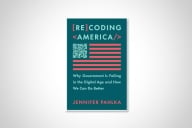You have /5 articles left.
Sign up for a free account or log in.
Having spent the latter part of last week focusing on getting The Girl settled in college, I didn’t immediately jump on the news about planned student loan forgiveness. Now that she’s safely ensconced, a few thoughts.
My overarching impression is that it will likely get struck down by the courts. Technically, to bring a suit, someone has to prove standing, or a right to sue based on harm they’ve suffered themselves. In this case, it’s hard to show who would have standing to bring the issue to court. (Simply objecting to a policy is not enough to confer standing.) No standing, no suit. But given how cavalierly the courts are treating laws they don’t like, I expect they’ll find a way to let someone attack it, then grant an injunction and finally strike it down. That’s true regardless of the merits of the case, which is a harrowing statement in itself. The judiciary isn’t supposed to be an unelected and unaccountable super-legislature, but here we are.
For the sake of argument, though, let’s say it survives a court challenge. Is it a good idea?
I’ll say, “Mostly, yes.”
The best argument for it, in my view, is that the highest default rates are among the borrowers with the lowest balances. This is the point the mainstream press misses entirely. Cardiologists with six-figure debts do just fine. The borrowers who are struggling are the ones who dropped out of college after a semester or two with nothing to show for it but debt. They usually owe a few thousand dollars, but if they’re on the margins of the economy, that’s often beyond what they can pay. Wiping away small debts will mean setting thousands of low-wage workers free from student loans entirely. That’s a very big deal, and an excellent idea. And the impact to the Treasury is likely small, since many of those loans were unlikely ever to be repaid anyway. Businesses routinely write off certain bad debts; this is consistent with business practice.
I also like that students who received Pell Grants are eligible for larger write-offs. Pell Grants only go to low-income students in the first place. They aren’t a perfect index of need, of course, but they’re pretty good and they have the virtue of already existing.
The income caps for loan forgiveness strike me as tricky. For traditional-age students, the loan will be in the student’s name, but the income measured is (presumably) the parents’. For current students of traditional age, that could lead to some awkward situations. (I assume that for older students and/or those for whom college is in the past, the income measured would be that of the borrower.) As it stands, my son would have the equivalent of a year of loans wiped out, even as he starts another year now. That’s not a complaint, but I would recommend taking a close look at the anomalies that could pop up with students who are still enrolled.
I find the “sanctity of contracts” argument unpersuasive, given how widely loan forgiveness has been extended to, say, business owners. If we assume that the pandemic was not students’ fault—which seems reasonable—then holding them responsible for loans, while giving business owners a free pass, seems like a double standard. And that’s before even addressing why student debts are immune to bankruptcy declarations, unlike most other debts. Debt forgiveness is a historical practice of long standing; anyone who doubts that is invited to investigate the biblical meaning of the term “jubilee.”
The most compelling objections, to my mind, are twofold. The first is that student debt isn’t the only kind of debt: what about other debts? The second is the “now what?” problem.
The “what about other debts?” objection makes some sense in a vacuum, but less in context. Most other debts are dischargeable through bankruptcy; student loans are not. And the student loans in question were issued by a single lender; consumer debts are issued by all sorts of different lenders. That makes the implementation of forgiveness at scale much harder. (It also limits the real-world impact of forgiveness; many students or their families also have private loans, which are unaffected.) To the extent that higher education is a public good, I see an argument for the public to resume offsetting more of the cost, like it did for earlier generations.
The “now what?” argument is the one with some sting. I’ll use my kids as examples. My son started college in 2019; he gets some debt forgiven. My daughter started college in 2022; she does not. I would expect her, and others similarly situated, to ask why not. It’s a fair question. From a macro perspective, one could argue that a one-time write-off amounts to bailing out the tub while the water is still running. A few years from now, we’ll likely have a whole new crop of students and former students with debt, wondering why other people got a break and they didn’t.
To my mind, the easy and obvious response to the “now what?” objection would be to allow existing borrowers to refinance at zero percent interest, and to issue the loans from now on at zero percent. Eliminating the interest but maintaining the principal is probably more consistent with many people’s moral intuition: you have to pay back every penny you borrowed, but no more than that. Every dollar repaid would whittle down the remainder. The best part would be equity across cohorts; my son and my daughter would be eligible for the same deal. Representative Joe Courtney (D-Conn.) has introduced a bill to do this; it could make a real, lasting and sustainable difference.
Of course, there’s another way to look at the “now what?” objection, which is that subsequent cohorts should press not only for loan forgiveness, but for greater public support of higher education in the first place so we can get away from student loans entirely. Regular readers know that I’m a fan of the idea of greater public support for higher education. That said, if even this much help required working around Congress, I can only imagine the obstacles to something much more ambitious. That’s a political calculation rather than an argument on the merits, but if something like this offers immediate help while setting the table for a better approach later, I’ll take it.
Assuming the courts don’t kill it, the net impact should be to help some folks who really need it, and to set a precedent that could lead to a more sustainable system. It’s not perfect, and I would have approached it differently, but it’s a net positive. Here’s hoping it survives.



